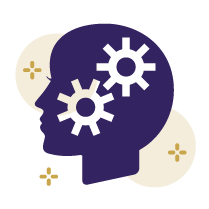
Attention & ADHD
Overview
Attention includes the ability to select and focus on what is important at any given moment, the ability to consistently maintain mental effort while performing tasks that require mental energy, and the ability to inhibit action or thought while previewing alternative actions or thoughts. Attention is a complex process that includes feeling alert and aroused, selecting what we should be attending to, ignoring what we don’t want to attend to, and maintaining our focus for the right amount of time. Attention allows us to plan or preview and monitor and regulate our thoughts and actions.
Attention is the first step in the learning process. We cannot understand, learn or remember that which we do not first attend to.
Students who have trouble with alertness and arousal may have difficulty getting to sleep at night and/or awakening in the morning. They may appear tired and sleepy throughout the day, particularly when they are required to perform tasks that do not especially interest them. Sometimes they describe this feeling as being “bored”.
Students who have trouble with selectivity or determining saliency seem to be tuned in to the wrong thing at the wrong time. They may be reading the problem when they should be listening to the teacher give directions, and they may have difficulty deciding the main idea of a paragraph they have just read.
Students who have trouble with distractibility may attend to the person who is walking down the hall when they should be listening to their teacher give the directions for an assignment. They may be more easily distracted by other students’ conversations in the classroom. In addition, students may be distracted by their own thoughts and therefore not hear important information in the classroom.

Students who have difficulty with sustaining mental effort become easily mentally fatigued and burn out quickly when performing tasks that are not particularly interesting to them or that require maintained focus.
People who have trouble with previewing skills are often called impulsive. They do not stop and think before they say or do something; they act before they think. They may say what everyone else thinks but knows not to say. They may blurt out things in the classroom. When performing academic tasks, they may not consider all the possibilities before stating an answer or performing a task.
Students who have problems with regulating the speed or pace of their work often work too slowly or too quickly. They may rush through their work and make careless mistakes because they are not taking enough time to do the work the right way. They may also not be very good at estimating how long a task will take.
Students who have trouble with self-monitoring often make careless mistakes. They may be doing something that annoys their peers, but fail to notice their peers’ responses to their behavior. They do not self-regulate.
Some students who have a high need for stimulation find the traditional classroom situation intolerable. They often create chaos or stir things up in order to increase the level of stimulation around them. They thrive on a level of arousal that some of us would experience as anxiety.
Some students have a hard time sitting still in school. They may frequently get up out of their desks. They may squirm or fidget in their seats. They might sit on their feet in their desks or shake their legs while they are seated. Other things that they might do to move around include tapping their pencils on their desks, doodling on their papers, twisting their hair or playing with an object in their hands. Often they will report that they actually think better when they are moving.
When attention is problematic for a student, s/he may have an Attention-Deficit Disorder. Attention-Deficit Disorders are neurological disorders that are characterized by levels of inattention and/or impulsivity and hyperactivity that are developmentally inappropriate. According to the National Institutes of Health, between 3% and 7% of the population in the United States are affected by Attention-Deficit Disorders.
There are three kinds of Attention-Deficit Disorders:
- Attention-Deficit Hyperactivity Disorder, Predominately Hyperactive-Impulsive Type
- Attention-Deficit Hyperactivity Disorder, Predominately Inattentive Type, often referred to as Attention-Deficit Disorder or ADD
- Attention-Deficit/Hyperactivity Disorder, Combined Type, in which inappropriate levels of both inattention and hyperactivity-impulsive behaviors are present
Resources
Barkley, R. A. (2003). Attention-Deficit/Hyperactivity Disorder. In E. J. Mash & R. A. Barkley (Eds.), Child Psychopathology. NY: The Guilford Press.
Berninger, V. W. & Richards T. L. (2002). Brain literacy for educators and psychologists. San Diego, CA:Academic Press.
Goldstein, S. & Naglieri J.A. (2006). The role of intellectual processes in the DSM-V diagnosis of ADHD. Journal of Attention Disorders, 10, 3-8.
Hallowell, E. M. & Ratey, J. J. (2005). Delivered from distraction: Recognizing and coping with attention deficit disorder from childhood through adulthood. New York: Ballantine Books.
Hallowell, E. M. & Ratey, J. J. (1994). Driven to Distraction: Recognizing and Coping with Attention Deficit Disorder from Childhood through Adulthood. New York: Simon and Schuster.
Handler, M. W. & DuPaul, G. J. (2005). Assessment of ADHD: Differences across psychology specialty areas. Journal of Attention Deficits, 9, 402-412.
Hattie, J. (2013). Visible learning and the science of how we learn. New York: Routledge.
Thomas, A. (2013). Retention is not the answer. www.cdl.org.
Thomas, A. and Thorne, G. (2010). Differentiating instruction: 150+ targeted strategies for diverse learners. Metairie, LA: Center for Development and Learning.
Thomas, A. (2010). How minds work: The key to motivation, learning and thinking. www.cdl.org.
